Courtesy of the International Maxi Association.
From New Zealand Endeavour to Bella Mente: Mike Sanderson on his three decades maxi racing.
In yacht racing circles he is best known for skippering ABN AMRO One to victory in the 2005-06 Volvo Ocean Race, and more recently in the industry as the new owner of Doyle Sails, but, as a sailor, for almost three decades Mike Sanderson has been involved in more consistently top level maxi racing yacht projects than perhaps anyone. Moose, as he is known, spoke to the International Maxi Association about his trail-blazing career.
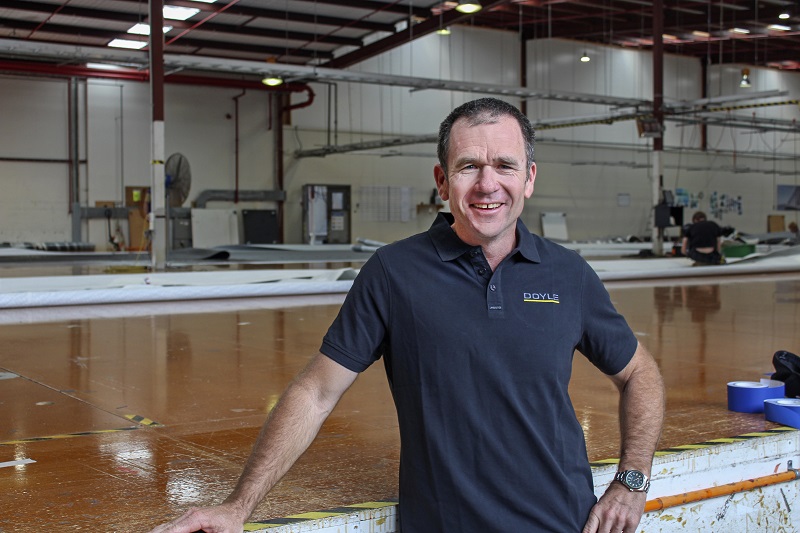
There was some consternation when in 1988 a 17-year-old Sanderson quit the top public school he was attending in his native Auckland a year prematurely in order to become a sailmaker. This, he rightly anticipated, would be step one towards his ultimate aim of becoming a professional sailor. His inspiration came through this being the first halcyon era of Kiwi yachting: the Chris Dickson-led Kiwi Magic had proved an exceptional challenge for the 1987 America’s Cup, comfortably winning the round robin stage, while offshore Peter Blake was mounting his Steinlager campaign that would go on to win every leg of the 1989-90 Whitbread Round the World Race.
Having been perpetual runner-up to Steinlager with his Fisher & Paykel, skipper Grant Dalton was not going to be outgunned again and for the 1993-94 race entered the ultimate (and final) Whitbread maxi ketch, New Zealand Endeavour. Recommended to Dalton by his former navigator Murray Ross, a 21-year-old Sanderson managed to hitch a ride as a trimmer/driver, in awe at sailing alongside many of his heroes from KZ7 and Steinlager. At the time, the round the world race was still relatively untainted by safety measures such as ice gates or commercial pressures to visit Asia, but uniquely, for anti-aparteid reasons, was the one race to miss Cape Town – instead its second leg was a giant from Punta del Este, Uruguay directly to Fremantle, Australia. As Sanderson recalls: “We ended up really far south with icicles on deck and the wind gear freezing and very early Gore-Tex type wet weather gear which leaked like a sieve. And we broke the mizzen on that leg. We still led for a long time but finally we got mowed down by Merit coming into Fremantle.”
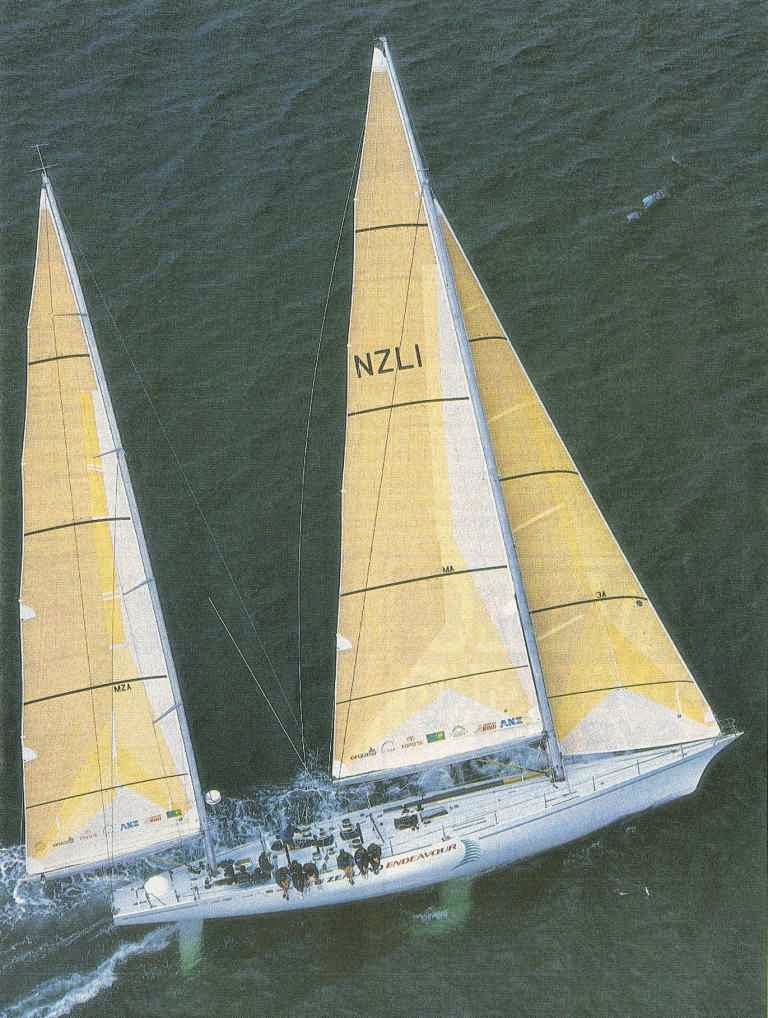
Despite the new spritely water ballasted Whitbread 60s nearly beating them on the water, loudly sounding the death knoll for the IOR maxis, it was nonetheless a fantastic end-of-era experience for the impressionable Sanderson. “We did something like 26 knots, but the maxi ketches were ridiculously contorted slave ships! We had around 23 sails on board, five or six different mizzen staysails alone, so it was a constant peeling frenzy all the way around the world, with guys out on the end of the spinnaker poles, dip pole gybing and some very nice Kevlar panelled sails!”
Alongside another Whitbread with Dalton again four years later on the Whitbread 60 Merit Cup when, aged 26, he was watch captain, the late 1990s were an intense period for Sanderson’s maxi yacht sailing. With Dalton he continued on to the relatively short-lived Grand Mistral/Maxi One Design circuit – initially an attempt by Swiss round the world maxi skipper Pierre Fehlmann to set up a one design oceanic racing circuit in identical water ballasted Farr 80s, the fleet eventually owned by Ernesto Bertarelli prior to his America’s Cup involvement.
Sanderson sailed on board the all-black Frers 93 Stealth while she was in the USA, training for a transatlantic record attempt that ultimately never happened. At a time when her owner, the ‘King of Italy’, renowned Fiat boss Gianni Agnelli, was regularly on board: “It’s been amazing watching these Ford versus Ferrari documentaries recently and seeing what a legend he was.” He also got a taste of Californian turbo sled competition, competing on board Robert McNeill’s Reichel-Pugh 75 ULDB Zephyrus IV, which not only won but set a course record for the Cape-Rio Race in 2000.
Significantly in 1999 he was part of the crew, led by Chris Dickson, on Larry Ellison’s all-conquering Farr 79 ILC maxi Sayonara, consecutive winner of the Maxi Worlds between 1997 and 1999 – also at a time when Ellison was regularly competing. Sayonara was Ellison’s first boat after he had been introduced to Bruce Farr and Geoff Stagg, plus Team New Zealand by David Thompson, a Kiwi sailor living in San Francisco who went to the same gym as Ellison. This was how many of the Kiwi legends such as Brad Butterworth ended up racing with Ellison between their victorious 1995 and 2000 America’s Cups. Aside from her star crew, Sayonara’s success says Sanderson lay in a very well run program by Bill and Melinda Erkelens, working with the Farr office to optimise her IMS rating from regatta to regatta. It was allegedly while having dinner aboard Ellison’s superyacht Katana, while at Antigua Sailing Week that Team New Zealand’s Tony Rey (aka Trey) first suggested to Ellison that he should get involved in the America’s Cup. “Larry was most put out because lots of our guys went to sail at Oracle, but not Trey, who stayed at Team New Zealand…”
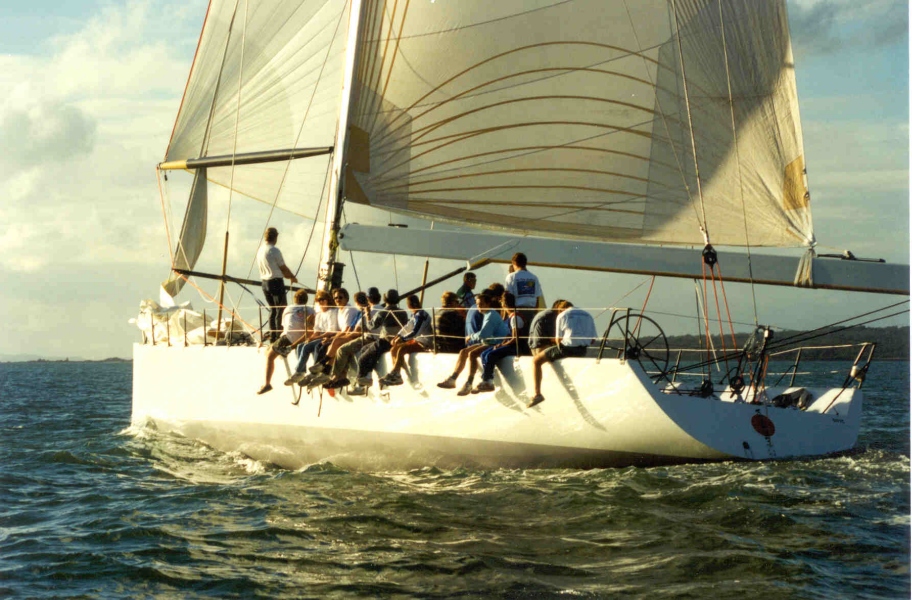
Racing on Sayonara led to Sanderson getting the position of main sheet trimmer on Oracle BMW Racing, Ellison’s first challenge for the America’s Cup in Auckland in 2003.
But Sanderson’s most consistent maxi yacht program, which began at this time, is Robert Miller’s Mari-Chas. In 1997, Miller was in the process of graduating up from his Frers 92 Mari-Cha II (subsequently Bristolian) to a new 47m Briand ketch, Mari Cha III. At the time she was in construction at Sensation Yachts in New Zealand and the story goes that Miller’s long term project manager and boat captain Jef d’Etiveaud had phoned North Sails in Auckland and the receptionist had called out to the boss Tom Dodson “I’ve got a guy on the phone who’s building a 47ft ketch”. Believing it to be a more modest craft, Dodson had passed it on to Sanderson as their ‘ketch expert’. “I didn’t say anything to anyone but I got in my car and drove out to Sensation to meet Jef and here, 23 years on, the rest is history!”
The Mari Cha campaign was especially attractive for Sanderson as it was both inshore and offshore. Following his Whitbread on Merit Cup, Sanderson and leading Kiwi bowman Richard Meacham, found themselves the lone English speakers, alongside the owner Robert Miller, on Mari-Cha III when she broke the monohull transatlantic record, from New York to the Lizard, in 1998. Given his credentials, despite still only being in his 20s, Sanderson from then on became Mari-Cha’s racing skipper and he was able to become deeply immersed in the design team that created Miller’s next, even more extreme maxi. While his previous yacht had a full luxury interior, the new 42m long yacht was stripped out, fitted with a canting keel (and a 10 tonne bulb) and rigged as a schooner. At the time of her launch at JMV Industries in 2003, Mari-Cha IV was the world’s longest (and soon to be fastest) racing monohull.
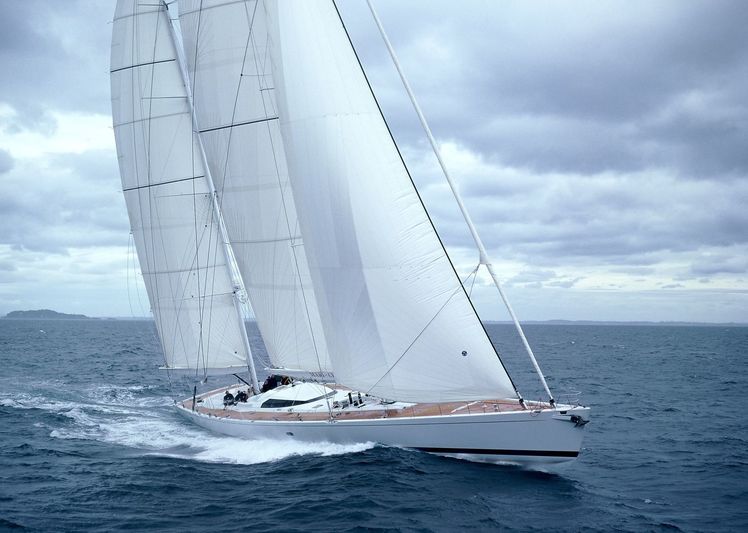
“That was a very cool project,” recalls Sanderson. “One of the key drivers at the time was how big we could build 3DL mainsails – so we had the option of a 100-110ft sloop or a 130-140ft schooner.” Running simulations on the transatlantic record course it became very obvious that longer was faster. Most impressively, just two months after her launch in France, Mari-Cha IV demolished the monohull west to east Transatlantic record setting a time of 6 days 17 hours 52 minutes and 39 seconds (18.2 knots average) that would stand for another 13 years. “The stars aligned for us at every point,” Sanderson recalls. “We had a fantastic crew [including many of the French Vendée Globe and multihull sailor rock stars], the owner had a great time, we didn’t break anything of any substance. All in all it was a roaring success.”
During the record she had also set a new monohull 24 hour record of 525 miles, becoming the first monohull to break the 500 mile/day (20.8 knot) barrier – although today monohulls are achieving this sailed singlehanded!
Mari-Cha IV’s collosal size also held other benefits. Sanderson recalls: “If we got caught without being able to peel or if we’d broken something and we had to do a bare-headed change that boat would still happily tick along at 17 or 18 knots while you were getting ready.”
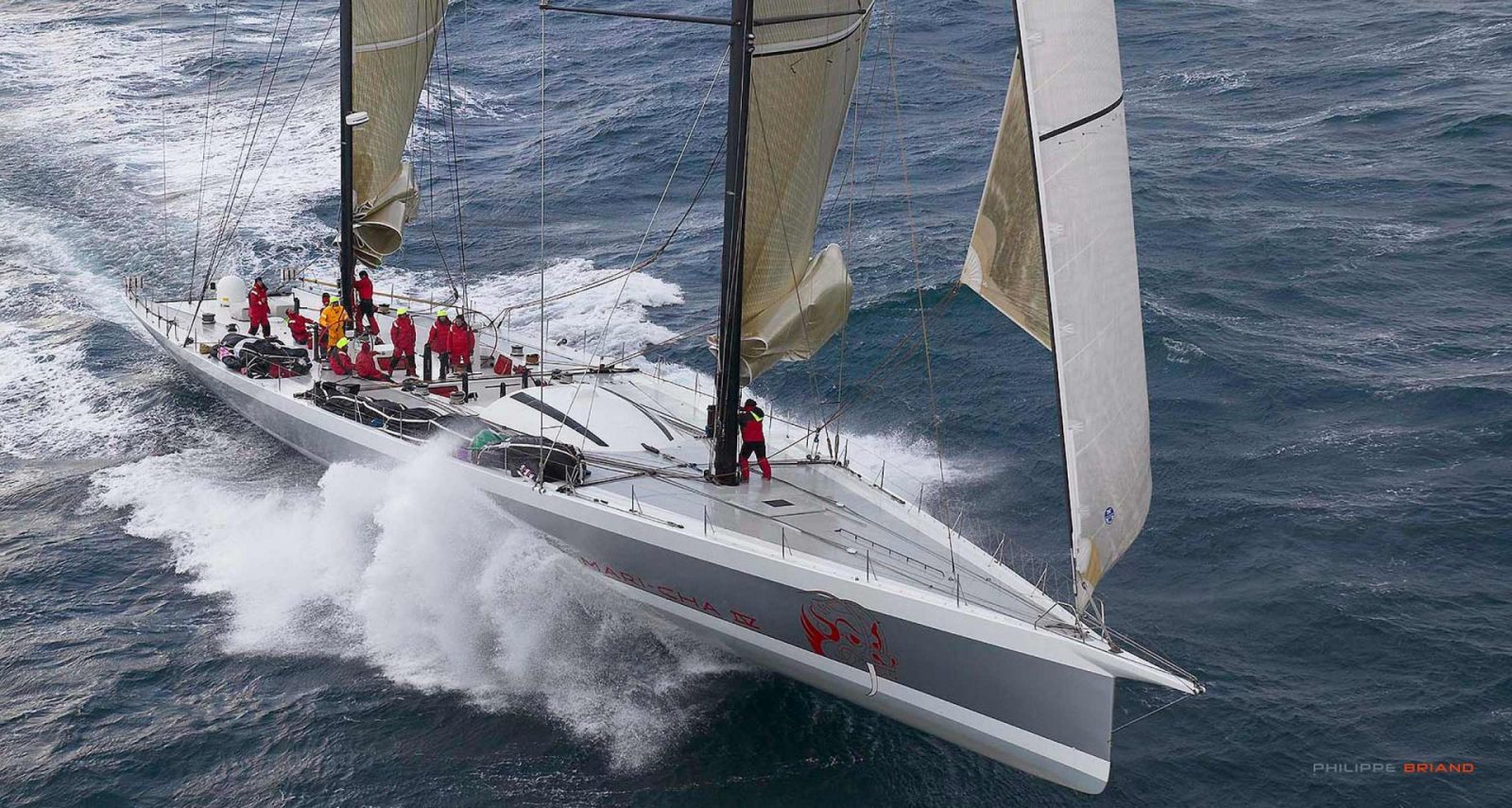
Miller and his crew subsequently went on to win the Rolex Transatlantic Race from New York to the Lizard and on to Cowes in 2005, marking the centenary of the New York Yacht Club’s famous race for the Kaiser’s Cup, won by Charlie Barr and the three masted schooner Atlantic.
While Mari-Cha IV has long since sold (now renamed Samurai, she has been detuned and refitted by Royal Huisman with a superyacht interior), Miller, albeit now well into his 80s, continues to race and cruise with his family and his long standing team, including Sanderson, on board Mari-Cha III. The slippery giant ketch received a significant make-over in 2017, which involved adding 3m extra to the main and mizzen masts and fitting square-topped mainsails, EC6 composite rigging and halyard locks. “The boat is now an ORC weapon in my opinion,” says Sanderson. “We were very unlucky not to win the Superyacht Cup in Palma that year.”
While Sanderson made a brief foray into the IMOCA 60 class, with a new boat designed by Juan Kouyoumdjian and backed by Andrew Pindar, his greatest achievement as a sailor came when he was recruited to skipper ABN AMRO One, the Dutch-flagged Volvo Open 70 in the 2005-06 Volvo Ocean Race. He recalls: “There was a lot of pressure, but we were also given every opportunity – we wanted for nothing, we had no restrictions on crew, we could train wherever in the world we wanted to, we could build two boats, we had a great sail budget and a great, great bunch of people right from the start.”
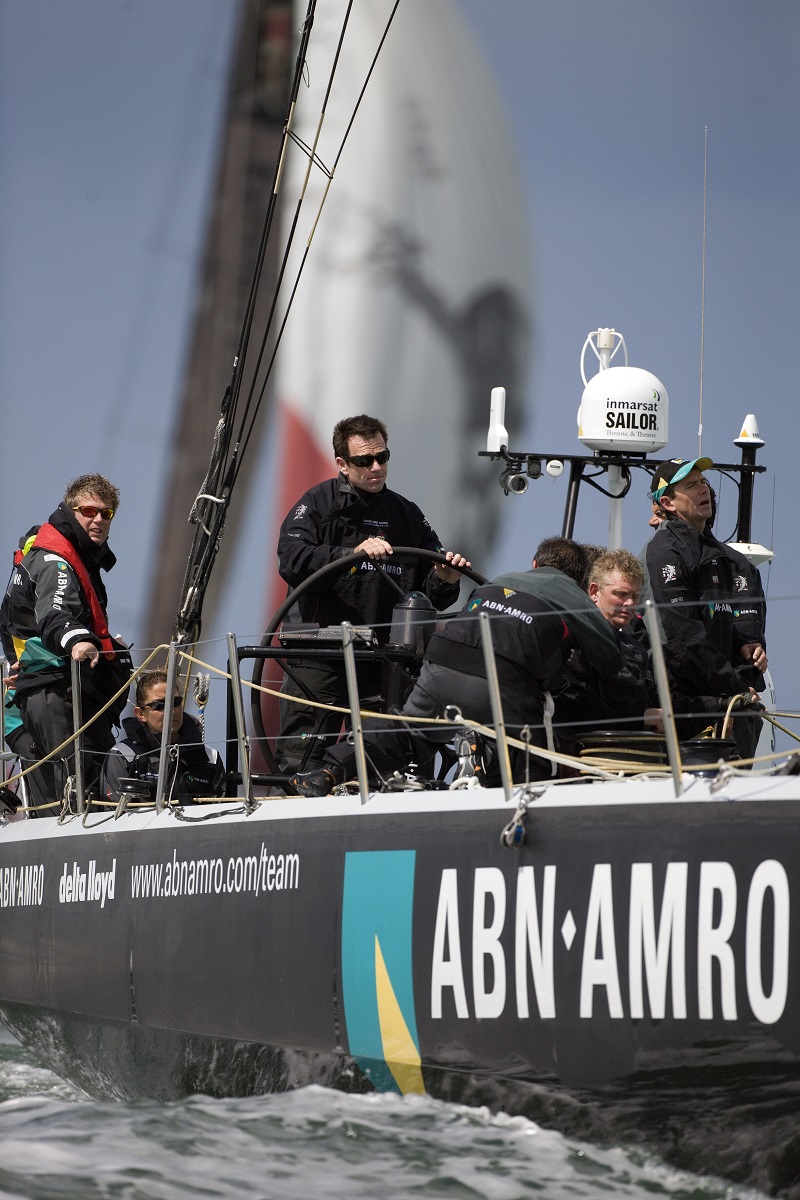
ABN AMRO One dominated the 2005-06 Volvo Ocean Race, the first for the new generation Volvo Open 70s, winning six of its nine legs. But it was also a rollercoaster of highs and lows – on the one hand getting married to Emma Richards with his crew all acting as grooms at the Royal Yacht Squadron in Cowes, on the other the sad sad loss of popular Dutch crewman Hans Horrevoets from on board the ABN AMRO ‘youth boat’ during the Transatlantic leg, something which he admits haunts him to this day.
In part two of this article – to be published on Monday May 10 th – Sanderson discusses his part in Hap Fauth’s multiple Maxi 72 World Championship winning Bella Mente campaign, his acquisition of Doyle Sails and how he believes the pandemic is going to affect the pro sailing world.
(By James Boyd / IMA) https://bit.ly/2WcLUQ6
